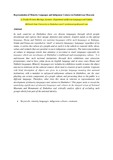Please use this identifier to cite or link to this item:
https://cris.library.msu.ac.zw//handle/11408/2813Full metadata record
| DC Field | Value | Language |
|---|---|---|
| dc.contributor.author | Muringa, Tendai Fortune | - |
| dc.date.accessioned | 2017-09-05T13:32:13Z | - |
| dc.date.available | 2017-09-05T13:32:13Z | - |
| dc.date.issued | 2012 | - |
| dc.identifier.uri | http://hdl.handle.net/11408/2813 | - |
| dc.description.abstract | In such countries as Zimbabwe there are diverse languages through which people disseminate and express their unique identities and cultures. English stands as the official language, Shona and Ndebele are national languages whilst such languages as Kalanga, Venda and Tonga are regarded as ‘small’ or minority languages. Language regardless of its status, it carries the culture of a people and as such it is the vehicle to transmit skills, ideas, values and symbols that are peculiar to each indigenous community. The interconnectedness of culture to language entails that attention is accorded to small languages especially by museums which are storehouses of Zimbabwe’s traditional and contemporary culture. It is unfortunate that such national institutions, through their exhibitions and education programmes, tend to have prime focus on English language and in some cases Shona and Ndebele languages. Minority languages are included in exhibitions mainly to name the object and not to elaborate on the cultural context which lead to creation of such symbols. Captions with brief description of objects are given in a foreign language meaning that national institutions, with a mandate to safeguard indigenous cultures in Zimbabwe, are the ones plucking out certain components of a people culture and presenting them to the public in a different language. Therefore, what does this mean in relation to representation and development of minority languages and cultures in Zimbabwe? This paper seeks to reveal the underlying significance of minority languages and cultures in the integral vision of National Museums and Monuments of Zimbabwe and critically analyse effects of excluding such groups which form part of the national identity. | en_US |
| dc.language.iso | en | en_US |
| dc.publisher | Midlands State University | en_US |
| dc.subject | Minority languages | en_US |
| dc.subject | Indigenous cultures | en_US |
| dc.subject | Museums | en_US |
| dc.title | Representation of minority languages and indigenous cultures in Zimbabwean museums: paper presented at the international conference at the West Indies university 2-5 Aug 2012 | en_US |
| item.languageiso639-1 | en | - |
| item.grantfulltext | open | - |
| item.fulltext | With Fulltext | - |
| Appears in Collections: | Conference Papers | |
Files in This Item:
| File | Description | Size | Format | |
|---|---|---|---|---|
| Tendai Fortune Muringa international conference at west idies university from 2-5 august 2012.pdf | Full Text | 858.3 kB | Adobe PDF |  View/Open |
Page view(s)
92
checked on Apr 11, 2025
Download(s)
74
checked on Apr 11, 2025
Google ScholarTM
Check
Items in MSUIR are protected by copyright, with all rights reserved, unless otherwise indicated.



